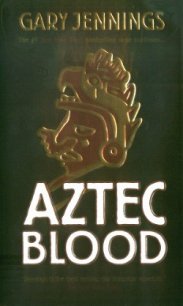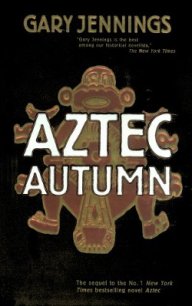Aztec - Jennings Gary (книги хорошем качестве бесплатно без регистрации TXT) 📗
Like their divided land, the Maya themselves are no longer one people under one ruler. They have fragmented into a profusion of tribes headed by petty chiefs, and all are mutually contemptuous and disparaging, and most of them are so dispirited and sunk in lethargy that they live in what their ancestors would have considered disgusting squalor. Yet every one of those splinter tribes preens itself on being the sole and only true remnant of the master Maya race. I personally think the oldtime Maya would disavow relationship with any of them.
Why, the louts cannot even tell you the names of their ancestors' once great cities, but call them anything they please. One such city, though now smothered in jungle, still shows a sky-reaching pyramid and a turreted palace and numerous temples, but it is unimaginatively called Palemke, the Maya word for any trivial "holy place." In another abandoned city, the interior galleries have not yet all been invaded by destructive vines and creepers, and on those inside walls are skillfully painted murals depicting warriors at battle, court ceremonies, and the like. The descendants of those warriors and courtiers, when asked what they know of the place, shrug indifferently and speak of it as Bonampak, which means only "painted walls."
In Uluumil Kutz is a city almost unravaged by erosion, and it might well be known as The Place of Man-Made Beauty, to honor the intricate yet delicate architecture of its many buildings; but it is called only Uxmal, meaning "thrice-built." Another city is superbly situated on a hilltop overlooking a wide river, deep in the jungle. I counted the ruins or foundations of at least one hundred tremendous edifices built of green granite blocks, and I believe it must have been the most majestic of all the old Maya centers. But the wretches now living roundabout call it merely Yaxchilan, which is to say a place where there are some "green stones."
Oh, I will grant that some of the tribes—notably the Xiu of the northern peninsula and the Tzotxil of the southern jungles—still manifest some intelligence and vitality and a regard for their lost heritage. They recognize classes according to birth and status: noble, middle, bonded, and slave. They still maintain some of the arts of their ancestors: their wise men know medicine and surgery, arithmetic and calendar keeping. They carefully preserve the countless thousands of books written by their predecessors, though the fact that they know so little of their own history makes me doubt that even their best-educated priests ever take the trouble to read the old books.
But even the ancient, civilized, and cultured Maya observed some customs we moderns must regard as bizarre—and it is unfortunate that their descendants have chosen to perpetuate those eccentricities while letting so many more worthy traits wither away. To an outsider like me, the most noticeable grotesquery is what the Maya regard as beauty in their own appearance.
From the evidence of the oldest paintings and carvings, the Maya have always had hawk-beak noses and receding chins, and they have forever striven to enhance that resemblance to birds of prey. What I mean is that the Maya, ancient and current, have deliberately deformed their children from birth. A flat board is bound to a baby's forehead and kept there throughout its infancy. When it is finally removed, the child has a forehead as steeply receding as its chin, thus making its naturally prominent nose seem still more of a beak.
That is not all. A Maya boy or girl, however otherwise naked, will always be wearing a pellet of clay or resin suspended by a string around the head so that it dangles right between the eyes. This is intended to make the child grow up cross-eyed, which the Maya of all lands and classes deem another mark of surpassing beauty. Some of the Maya men and women have eyes so very crossed that I think it is only the clifflike nose between which keeps the eyes from merging. I have said that there are many beautiful things in the jungle country of Tamoan Chan, but I would not include the human population among them.
I probably would have ignored all the unattractive, hawk-faced women, except that—in a village where we spent the night, a village of the cleanly Tzotxil—one girl seemed to gaze at me with a determined fixity, and I assumed she had been smitten with passion for me at first glance. So I introduced myself by my latest name: Dark Cloud is Ek Muyal in their language, and she shyly confided that she was Ix Ykoki, or Evening Star. Only then, standing close to her, did I discern that she was exceedingly cross-eyed, and I realized that she probably had not been looking at me at all. Even at that moment when we were face to face, she could have been staring at a tree behind my back, or her own bare foot, or maybe both at once, for all I could determine.
That somewhat disconcerted me, but curiosity impelled me to persuade Ix Ykoki to sleep that night with me. And I do not mean that I was fired by any prurient curiosity as to whether a girl with crossed eyes might be interestingly peculiar in her other organs. It was simply that I had for some time been wondering what the act of copulation, with any female, might be like in one of those hanging, free-swinging net beds. I am pleased to report that I found it not only possible but also delightful. Indeed, I was so transported that it was not until we lay apart in the swaying gishe, spent and sweaty, that I realized I had given Ix Ykoki a number of love bites, and that at least one of them had drawn a bead of blood.
Of course that made me remember the warning words of Doctor Maash, when he had administered the snakebite treat-met, and I lay awake through most of the rest of the night, suffering an agony of apprehension. I waited for Ix Ykoki to go into convulsions, or to stiffen slowly and grow cold beside me, and I wondered what kind of punishment the Tzotxil dealt out to murderers of their women. But Ix Ykoki did nothing more alarming man to snore all night through her great nose and in the morning she bounded jauntily from the bed, her crossed eyes bright.
I was happy that I had not slain the girl, but the fact also perturbed me. If the bungling old pulse doctor who told us that our own teeth were now poisonous had merely been repeating one of his people's stupid superstitions, there was every likelihood that Cozcatl and I were not at all protected against the venomous snakes—or that Blood Glutton ever had been. I so advised my partners, and thereafter we watched even more closely where we put our feet and hands as we made our way through the jungle.
A little later, I made the acquaintance of another physician, of the kind I had wanted for so long and had come so far to see: one of those Maya doctors famed for their ability to treat ailments of the eye. His name was Ah Chel, and he was also of the Tzotxil tribe, and Tzotxil means Bat People, which I took as a good omen, since bats are the creatures which see best in the darkness. Doctor Ah Chel had two other assets which recommended him to me: he spoke an adequate Nahuatl, and he was not himself cross-eyed. I think I would have been somewhat distrustful of a cross-eyed eye doctor.
He indulged in no pulse feeling or god calling or other mystic means of diagnosis. He began straightforwardly by putting into my eyes drops of juice from the herb camopalxhuitl, to enlarge my pupils so he could look inside them. While we waited for the drug to take effect, I talked—perhaps just to ease my own nervousness—and told him of that sham Doctor Maash, and the circumstances of Ten's illness and death.
"Rabbit fever," said Doctor Ah Chel, nodding. "Be glad that none of the rest of you handled that diseased rabbit. The fever does not kill of itself, but it weakens the victim so that he succumbs to another ailment which fills the lungs with a thick liquid. Your slave might still have lived if you had brought him down from the heights to a place where he could have breathed air more thick and rich. But now let us have a look at you."




